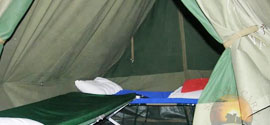Ruaha National Park

In the distance, beneath a bulbous baobab tree, a few representatives of Ruaha's 10,000 elephants - the largest population of any East African national park, form a protective huddle around their young.
Second only to Katavi in its aura of untrammelled wilderness, but far more accessible, Ruaha protects a vast tract of the rugged, semi-arid bush country that characterises central Tanzania. Its lifeblood is the Great Ruaha River, which courses along the eastern boundary in a flooded torrent during the height of the rains, but dwindling thereafter to a scattering of precious pools surrounded by a blinding sweep of sand and rock. Ruaha's unusually high diversity of antelope is afunction of its location, which is transitional to the acacia savannah of East Africa and the miombo woodland belt of Southern Africa. Grant's gazelle and lesser kudu occur here at the very south of their range, alongside the miombo-associated sable and roan antelope, and one of East AfricaÆs largest populations of greater kudu, the park emblem, distinguished by the male's magnificent corkscrew horns. A similar duality is noted in the checklist of 450 birds:
the likes of crested barbet, an attractive yellow-and-black bird whose persistent trilling is a characteristic sound of the southern bush, occur in Ruaha alongside central Tanzanian endemics such as the yellow-collared lovebird and ashy starling.
About Ruaha National Park
Size: 10,300 sq km (3,980 sq miles), Tanzania's 2nd biggest park.
Location: Central Tanzania, 128km (80 miles) west of Iringa.
Getting there
Scheduled and/or charter flights from Dar es Salaam, Selous, Serengeti, Arusha, Iringa and Mbeya.
Year-round road access through Iringa from Dar es Salaam (about 10 hours) via Mikumi or from Arusha via Dodoma.
What to do
Day walks or hiking safaris through untouched bush.
Stone age ruins at Isimila, near Iringa, 120 km (75 miles) away, one of Africa's most important historical sites .
Best time
For predators and large mammals, dry season (mid-May-December); bird-watching, lush scenery and wildflowers, wet season (January-April). The male greater kudu is most visible in June, the breeding season .




